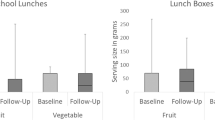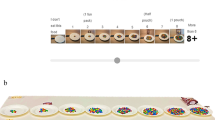Abstract
Altering the order in which meals are presented at cafeteria counters has been proposed as a way of lowering meat consumption, but remains largely untested. To address this, we undertook two experimental studies involving 105,143 meal selections in the cafeterias of a British university. Placing vegetarian options first on the counter consistently increased their sales when choices were widely separated (>1.5 m; vegetarian sales as a percentage of total meal sales increased by 4.6 and 6.2 percentage points) but there was no evidence of an effect when the options were close together (<1.0 m). This suggests that order effects depend on the physical distance between options.
This is a preview of subscription content, access via your institution
Access options
Access Nature and 54 other Nature Portfolio journals
Get Nature+, our best-value online-access subscription
$29.99 / 30 days
cancel any time
Subscribe to this journal
Receive 12 digital issues and online access to articles
$119.00 per year
only $9.92 per issue
Buy this article
- Purchase on Springer Link
- Instant access to full article PDF
Prices may be subject to local taxes which are calculated during checkout

Similar content being viewed by others
Data availability
Data for the results in this paper can be found at https://doi.org/10.17863/CAM.41481.
Code availability
The code used for this analysis is available from the corresponding author on request.
References
Poore, J. & Nemecek, T. Reducing food’s environmental impacts through producers and consumers. Science 992, 987–992 (2018).
Bryngelsson, D., Wirsenius, S., Hedenus, F. & Sonesson, U. How can the EU climate targets be met? A combined analysis of technological and demand-side changes in food and agriculture. Food Policy 59, 152–164 (2016).
Lehner, M., Mont, O. & Heiskanen, E. Nudging—a promising tool for sustainable consumption behaviour? J. Clean. Prod. 134, 166–177 (2016).
Thaler, R. & Sunstein, C. Nudge: Improving Decisions about Health, Wealth and Happiness (Penguin, 2009).
Bianchi, F., Garnett, E., Dorsel, C., Aveyard, P. & Jebb, S. A. Restructuring physical micro-environments to reduce the demand for meat: a systematic review with qualitative comparative analysis. Lancet Planet. Health 2, e384–e397 (2018).
Hollands, G. J. et al. Altering the availability or proximity of food, alcohol and tobacco products to change their selection and consumption. Cochrane Database Syst. Rev. 9, CD012573 (2019).
Meiselman, H. L., Hedderley, D., Staddon, S. L., Pierson, B. J. & Symonds, C. R. Effect of effort on meal selection and meal acceptability in a student cafeteria. Appetite 23, 43–55 (1994).
Kurz, V. Nudging to reduce meat consumption: immediate and persistent effects of an intervention at a university restaurant. J. Environ. Econ. Manage. 90, 317–341 (2018).
Garnett, E. E., Balmford, A., Sandbrook, C., Pilling, M. A. & Marteau, T. M. Impact of increasing vegetarian availability on meal selection and sales in cafeterias. Proc. Natl Acad. Sci. USA 116, 20923–20929 (2019).
Garnett, E. E., Balmford, A., Sandbrook, C., Pilling, M. A. & Marteau, T. M. Impact of increasing vegetarian availability on meal selection and sales in cafeterias. Proc. Natl Acad. Sci. USA 116, 201907207 (2019).
Campbell-Arvai, V., Arvai, J. & Kalof, L. Motivating sustainable food choices: the role of nudges, value orientation, and information provision. Environ. Behav. 46, 453–475 (2014).
Gravert, C. & Kurz, V. Nudging à la carte—a field experiment on climate-friendly food choice. Behav. Pub. Pol. 3, 1–18 (2019).
Kongsbak, I. et al. Increasing fruit and vegetable intake among male university students in an ad libitum buffet setting: a choice architectural nudge intervention. Food Qual. Prefer. 49, 183–188 (2016).
Cohen, J. F. W. et al. Effects of choice architecture and chef-enhanced meals on the selection and consumption of healthier school foods. JAMA Pediatr. 169, 431 (2015).
Greene, K. N., Gabrielyan, G., Just, D. R. & Wansink, B. Fruit-promoting smarter lunchrooms interventions: results from a cluster RCT. Am. J. Prev. Med. 52, 451–458 (2017).
Wansink, B. & Hanks, A. S. Slim by design: serving healthy foods first in buffet lines improves overall meal selection. PLoS ONE 8, e77055 (2013).
Simmons, J. P., Nelson, L. D. & Simonsohn, U. False-positive psychology: undisclosed flexibility in data collection and analysis allows presenting anything as significant. Psychol. Sci. 22, 1359–1366 (2011).
Uniware (Uniware, 2019); http://www.uniware.co.uk/
R Core Team R: A Language and Environment for Statistical Computing (R Foundation for Statistical Computing, 2020); https://www.R-project.org/
Acknowledgements
This work was supported by E.E.G.’s NERC studentship grant number NE/L002507/1 and A.B.’s Royal Society Wolfson Research Merit award. We thank Ivan, Danielle and Ian for participating and generously contributing their time and the cafeterias’ data. We thank G. Stewart, J. Williams and J. Chambers for assisting with monitoring fidelity to protocol; B. Simmons, K. Saunders and D.-L. Couturier for assistance with analyses and coding in R; and R. Pechey, E. Cartwright, G. Hollands and M. Vasiljevic for their advice in setting up the experiment and interpreting our findings. We thank K. Nielsen for his feedback on drafts of this manuscript.
Author information
Authors and Affiliations
Contributions
E.E.G., A.B., C.S. and T.M.M. designed the research; E.E.G. performed the research; E.E.G. and M.A.P. analysed the data; and E.E.G., A.B., C.S. and T.M.M. wrote the paper.
Corresponding author
Ethics declarations
Competing interests
The authors declare no competing interests.
Additional information
Publisher’s note Springer Nature remains neutral with regard to jurisdictional claims in published maps and institutional affiliations.
Supplementary information
Supplementary Information
Supplementary methods, discussion, Figs. 1–4 and Tables 1–11.
Rights and permissions
About this article
Cite this article
Garnett, E.E., Marteau, T.M., Sandbrook, C. et al. Order of meals at the counter and distance between options affect student cafeteria vegetarian sales. Nat Food 1, 485–488 (2020). https://doi.org/10.1038/s43016-020-0132-8
Received:
Accepted:
Published:
Issue Date:
DOI: https://doi.org/10.1038/s43016-020-0132-8
This article is cited by
-
Ethical Considerations When Using Nudges to Reduce Meat Consumption: an Analysis Through the FORGOOD Ethics Framework
Journal of Consumer Policy (2024)
-
Sustainable dietary choices improved by reflection before a nudge in an online experiment
Nature Sustainability (2023)
-
Low-cost climate-change informational intervention reduces meat consumption among students for 3 years
Nature Food (2023)
-
Assessment and scenario hypothesis of food waste in China based on material flow analysis
npj Urban Sustainability (2023)
-
Effects of single plant-based vs. animal-based meals on satiety and mood in real-world smartphone-embedded studies
npj Science of Food (2023)



